Article's Content
In the movie Any Given Sunday, as Al Pacino delivers a rousing speech to his team of underdogs before the biggest football game of their lives, he says the following:
“You find out life’s this game of inches — so is football.”
What he forgot to mention was this:
So is Saas marketing.
The commoditization of Saas is turning the tech landscape into a fierce competition where companies are duking it out for every inch of market share.
And over the last few years, the monday.com team out of Tel Aviv has executed a perfectly coordinated game plan. One that’s helped them achieve:
- A $7 billion valuation.
- Over 150,000 customers.
- The pinnacle of advertising success: a Super Bowl ad placement.
In this case study, I’ll take a deep dive into the coordinated offensive marketing strategy monday.com expertly executed to drive brand, marketing, and SEO growth in the crowded project management space.
Ready to go over the game tape?
Creating a Moat Through Long-Form Content Creation
Despite being a young underdog in the project management platform space, monday.com is leveraging high-quality content to compete with big names like Asana, Trello, Notion, and ClickUp. They’ve been punching above their weight ever since their founding in 2016.
And their content excellence is a big part of that, particularly in the past few years.

Monday.com invests heavily in the long-form content that is key to creating a successful SEO moat. Want receipts?
There are over 1,300 in their blog subfolder.
This content approach is helping them rank highly in the SERPs for some ridiculously valuable keywords, giving monday.com a major advantage over their competitors. Just check these out:
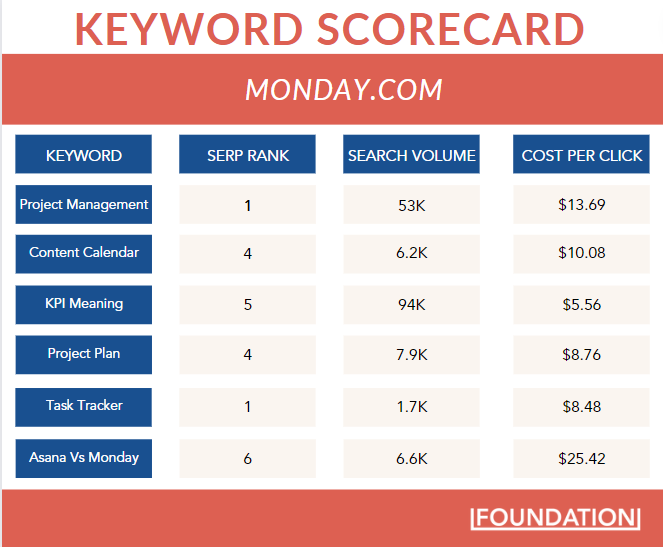
Across 3 core content marketing metrics — keywords, organic traffic, and backlinks — monday.com is seeing tremendous growth. Every month, over 200,000 people visit their site through keywords that would otherwise cost over $430,000 in paid advertising.
Again, it’s important to remember that monday.com is driving this value through investment in content. It’s like the run game: you might not see a big gain for drives at a time, but those inches start to add up eventually.
Other times? You hit a perfectly timed play and gain big.
Here’s one of monday.com’s most popular blog posts that perfectly exemplifies the latter:
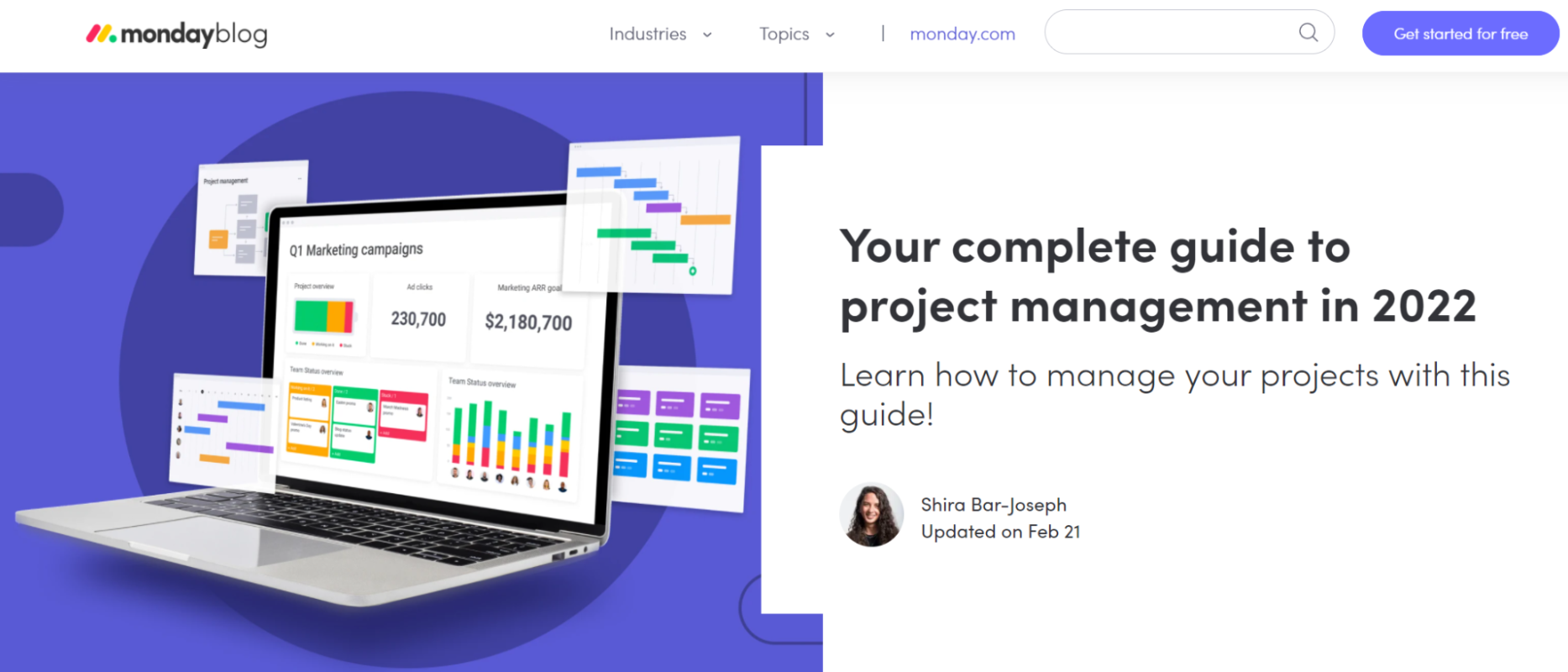
Monday.com’s complete guide to project management in 2022 is one of their big-gain plays. It’s accumulated:
Over 1,000 backlinks.
Ranks organically for 1,700 keywords.
And brings in nearly 12,000 organic visitors each month.
You’d need to spend over $100,000 dollars to drive that kind of traffic through paid ads. That’s a massive win for monday.com.
Let’s dissect exactly how they coordinate this type of high-octane offense.
As you should with any pillar page, monday.com’s project management guide is structured to align well with search intent. They’ve put keywords in every header, the concepts are broken down into concrete steps, and they’ve fully embraced the 3 E’s: Educate, engage, and entertain.
But it doesn’t stop there; they make sure every assignment is covered. After all, it’s the little things that ensure your content fights for every inch of yardage:
1. Ample internal links to move visitors down the funnel
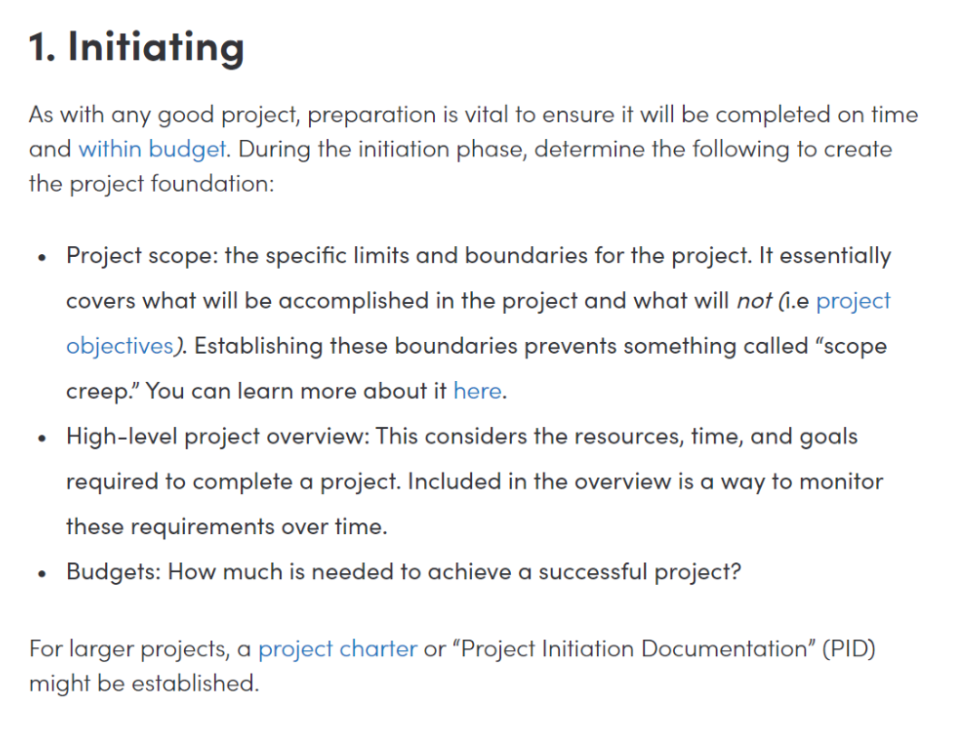
Monday.com is serious about its internal linking structure. Just look at the snapshot above: there are 4 internal links over the course of 100 words. And the entire post is thousands of words long.
That’s what I call maximizing every inch.
[memberful_sign_in_link]Sign in to your account.[/memberful_sign_in_link]
2. Perfectly placed statistics from third-party experts
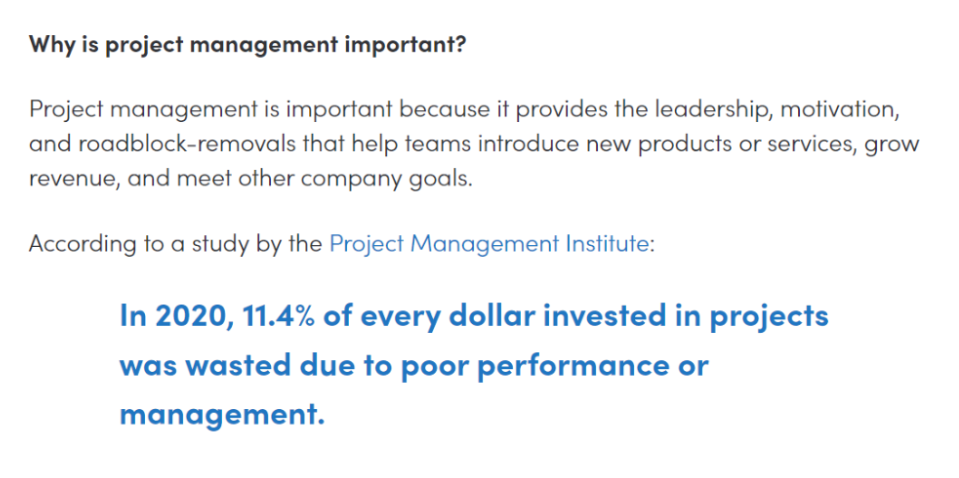
Internal links are important, sure. But when it comes to arguing the big stuff, say, “why is project management important?” it pays (literally) to cite some authoritative third-party sources. In the project management space, it doesn’t get much more authoritative than the Project Management Institute.
Educate, engage, entertain.
3. A mix of dynamic content, quality infographics, and informative screenshots
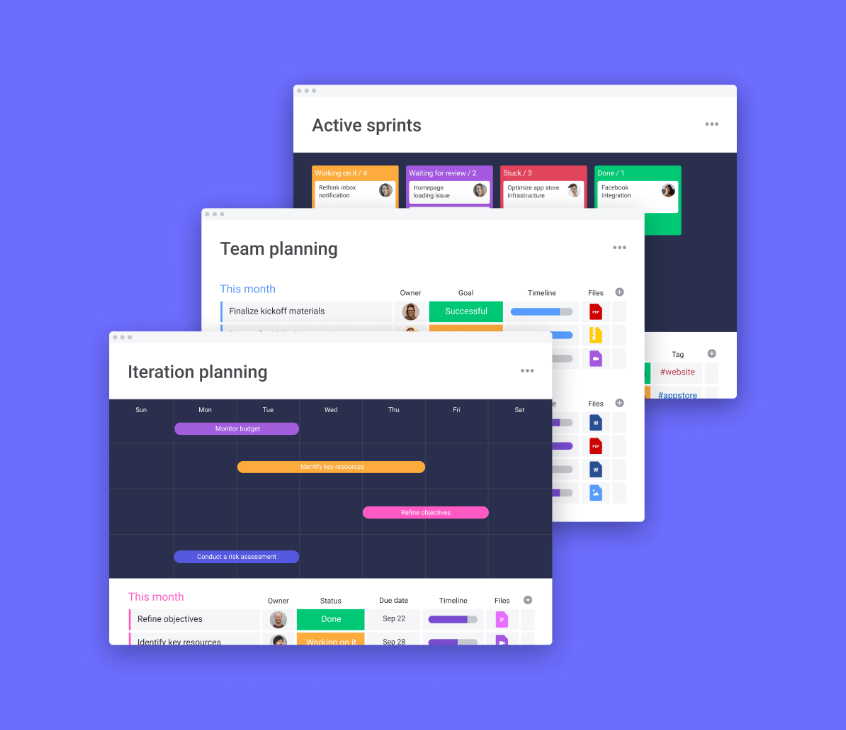
For any B2B Saas company, leveraging imagery is key.
The product itself might seem dry and unimportant, but potential customers need these products. They need to know what they do, why they matter, and how to use them.
Visual content is perfect for this, especially screenshots. They give page visitors a glimpse into the product before even signing up for a free trial.
4. A compelling CTA to drive traffic towards conversions
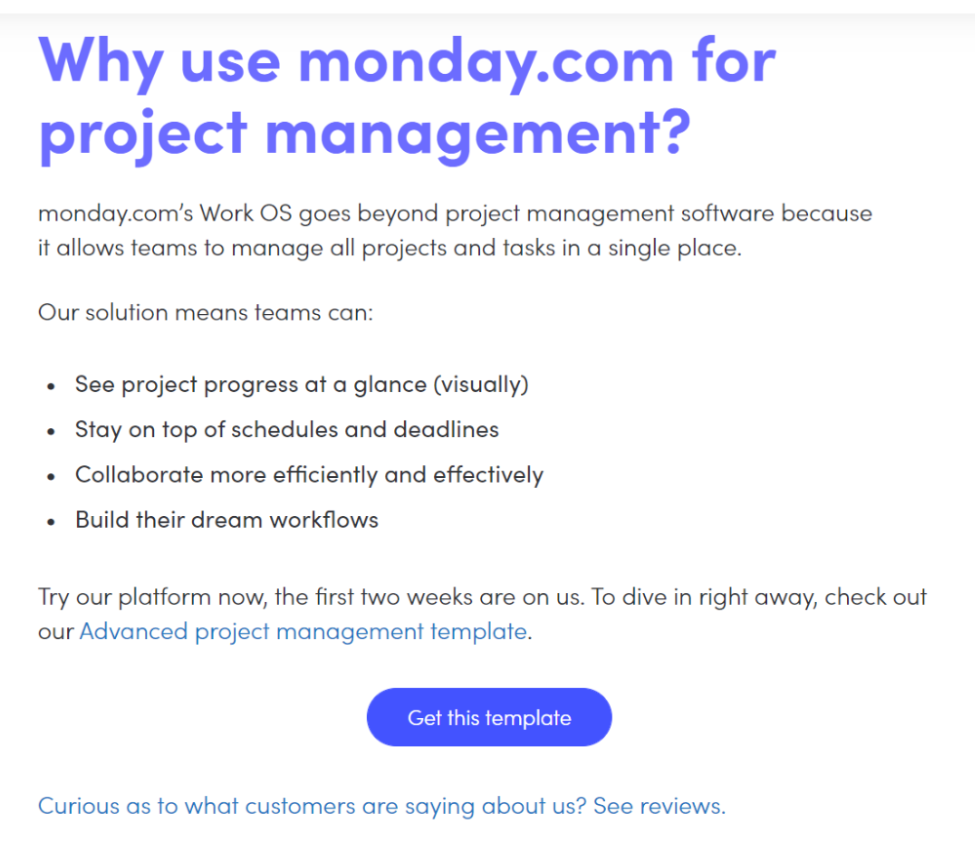
Now, this isn’t the flashiest, most inspiring CTA on the planet. Granted.
But what it lacks in design and UX appeal, it makes up for with concise and compelling copy. And when you take into consideration the vast number of internal links and “pre-CTAs” sprinkled throughout the piece, making it to this CTA at the bottom is icing on the cake, a two-point conversion.
Content marketing success is a straightforward process once the right plan and personnel are in place. Monday.com executes this process again and again, post after post. Eventually, the numbers begin to line up on your side.
Here’s a little exercise demonstrating this process perfectly:
Our keyword research finds that monday.com’s project management guide brings in around 12,000 visits each month.
Now let’s say the average monday.com contract is $2,000 (purely hypothetical, of course), and let’s give them a conservative conversion rate of 0.5% of all visitors.
That’s 60 new customers with an MRR of $120,000.
And, remember, that’s just one blog post.
But monday.com is far from a one-dimensional team.
They’ve diversified their arsenal so content is distributed in a number of different ways, from winning on review sites to product-led SEO to a wildly successful YouTube page.
Capitalizing on the Yelpification of B2B
The Yelpification of B2B is a straightforward but powerful phenomenon. Monday.com knows this first hand.
Yelp and Tripadvisor revolutionized the hospitality and other B2C industries by unlocking the power of user reviews. People are skeptical of promotional content that comes straight from companies, so these review sites gave power back to the consumer.
Well, the same thing has been happening in the Saas space for years.
Capterra. G2. TrustRadius. These powerful brands are built off the exact same process, except they amalgamate reviews for B2B Saas companies.
Taking a look at monday.com’s SimilarWeb data, you can see just how impactful the process of Yelpification is to their recent growth.
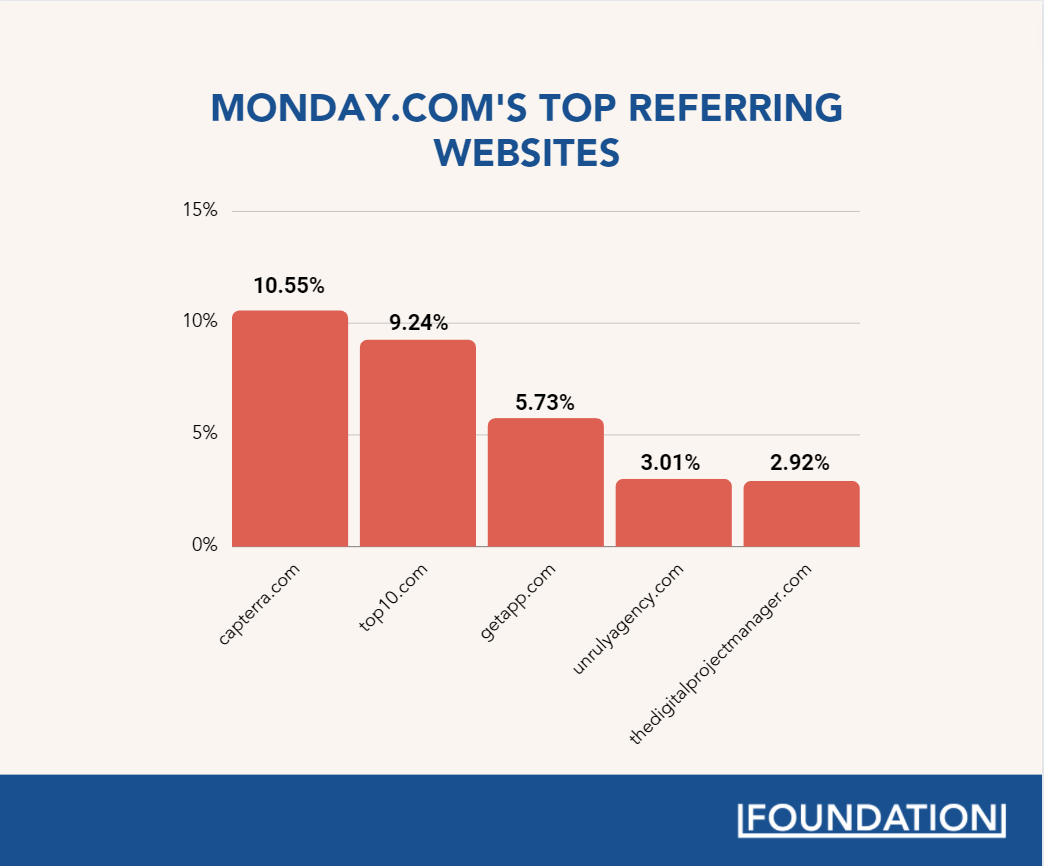
10.5% of their referral traffic comes from Capterra. The significance of this can’t be understated.
Here’s some more quick math.
With about 23 million monthly visitors and a 1.6% referral rate (10.55% of which arrive straight from Capterra), that’s over 38,000 highly motivated visitors coming to monday.com each and every month.
This is a massive advantage considering how tight the race is becoming between the top PM platforms on review sites. When matched up against their competitors on Capterra, monday.com ranks third. For G2, they’re second. On TrustRadius, second again.
So despite not winning the customer review game, monday.com is still managing to dominate in terms of Capterra referrals.
And they’re now bringing that same energy to their on-site content in the form of comparison pages like this:
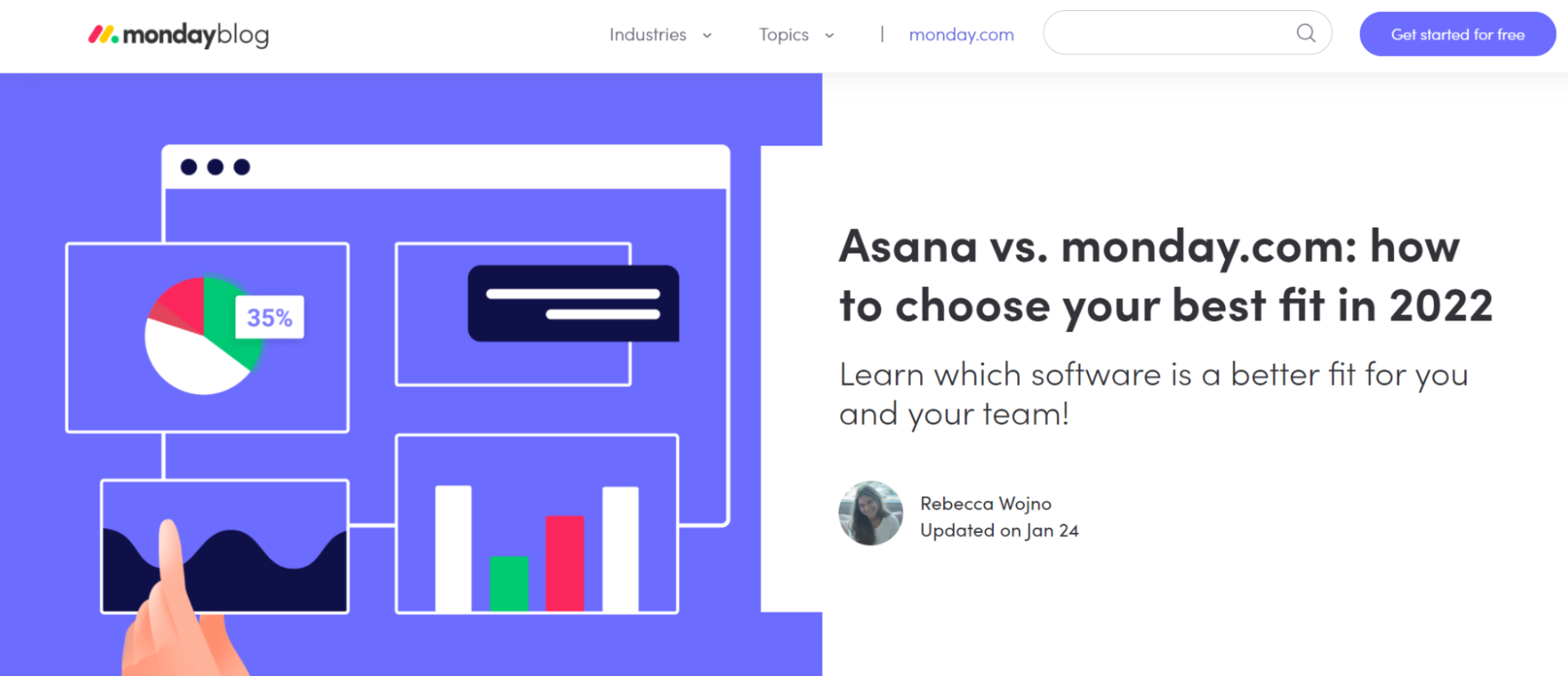
You might be wondering why the monday.com team is opting to bring attention to a prime competitor on their own blog page. Once again, it comes down to the popularity of Yelpification.

Take a look at that green highlighted section just under the search bar. Yup, you’re reading that right.
Monday vs asana has a cost-per-click over $25.
Essentially, every month there are nearly 2,000 people signaling through Google that they are ready to invest in project management software. This purchase intent is a big part of what makes this comparative keyphrase so valuable.
Especially to an underdog like monday.com.
Despite the successes of their marketing efforts, monday.com isn’t definitively winning their high-stakes matchup against Asana. This bottom-of-the-funnel-style content helps the monday.com team get past Asana’s defense while also optimizing their presence on sites like Capterra.
After all, why should monday.com let B2B review sites have all the fun?
And judging by the auto-suggest phrases pre-populated by Google, monday.com would do well to incorporate more “vs” style comparisons in their offensive marketing strategy.
Take a look at this:
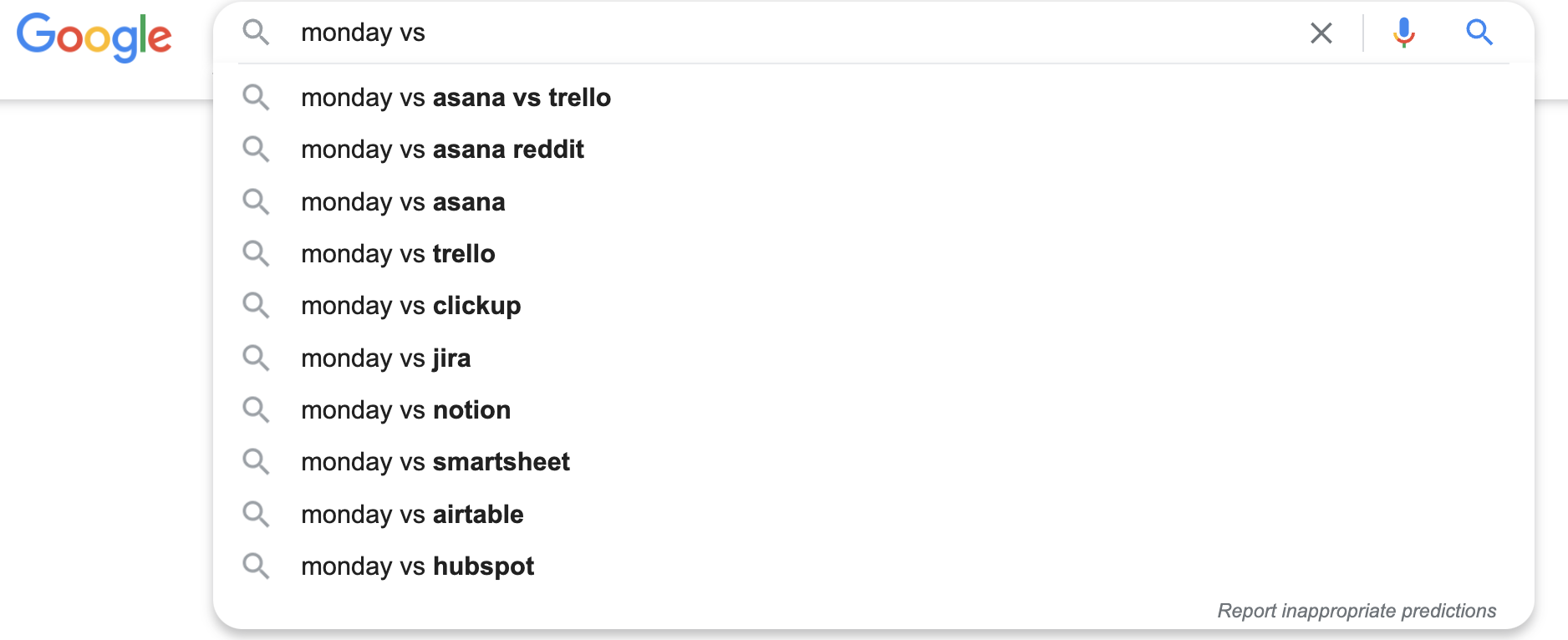
It’s interesting to see that neither monday.com nor Asana are winning this versus battle. Currently, the top spot is held by the comparison site Technology Advice. This provides a huge opportunity for Monday to utilize one of the most underappreciated tactics in the Saas space:
Influencer marketing.
This is also where tools like SparkToro come in handy. By using powerful audience insight functions like “hidden gems,” monday.com could develop a running list of prominent software bloggers and YouTubers. This type of third-party content is much higher in E-A-T than branded materials and can add yet another offensive weapon to the monday.com marketing team.
Remember, every inch counts.
Generating 2.3M Backlinks Through Product-led SEO
One of the components of monday.com’s growth plan that I found most interesting has to do with its link-building strategy. Particularly, how they’ve applied product-led SEO to catalyze their SEO growth.
Popularized recently by SEO expert Eli Schwartz, product-led SEO is a spin-off of the Silicon Valley approach known as product-led growth. The latter refers to creating a high-quality product that essentially sells itself through reviews, word of mouth, and overall customer satisfaction. The former applies this same concept to the world of SEO.
The rationale behind the product-led movement is that most popular SEO strategies are tailored towards algorithms instead of ICPs. Proponents say that developers, marketers, and SEOs are too busy crafting their products for search engines.
Sure, they say, you create background research and customer personas, and incorporate search intent, but is that the best way to scale rapidly?
According to Eli, “the product should become the SEO driver.”
While the concept is still in validation mode, it’s interesting to note that an often overlooked aspect of monday.com’s recent growth success is attributable to this model.
Let’s take a look at their backlink growth over the last few years, particularly, the large spike in the third quarter of 2021:

During the months of September, October, and November 2021, monday.com gained millions of new backlinks. What’s most interesting about this is that many of them came with the https://forms.monday.com/forms/ prefix and link to pages that look like this:
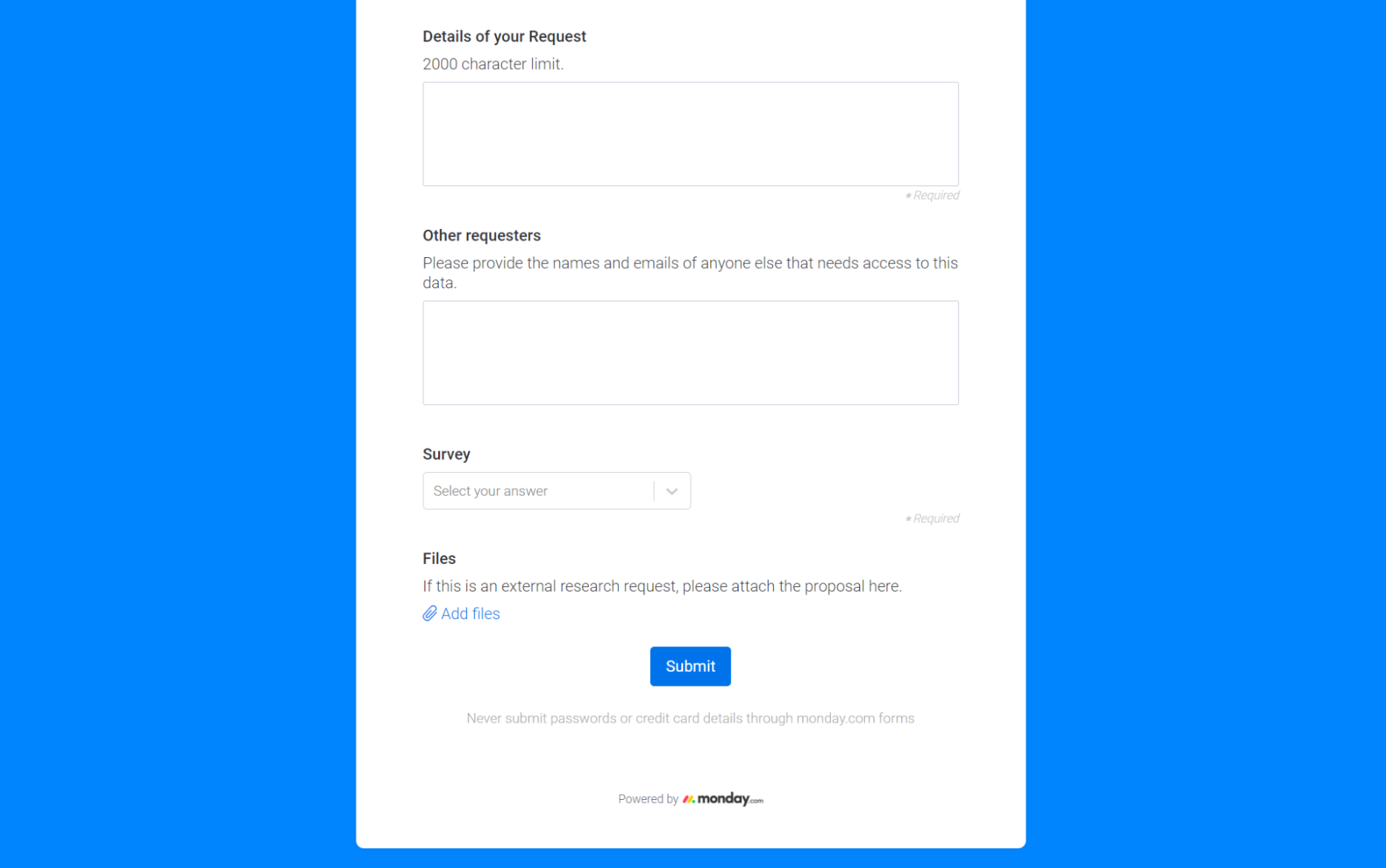
Thousands upon thousands of form pages that are powered by monday.com. Customer satisfaction forms, sign-up forms, internal team forms, the list goes on and on and on.
By improving its overall product features to meet customer needs, monday.com has also been growing its backlink network. It’s a true win-win and an interesting example of the concept of product-led SEO.
Diversifying Their Content Portfolio
I’m sure you’re well aware of this by now, but it bears repeating: distribution is key.
Generating good content is just half the battle. You need to constantly repurpose content to make it digestible for as many different consumers as you can. Successful B2B marketing is all about leveraging your assets.
The SimilarWeb data below shows how monday.com is investing effort across different social channels, and distribution is clearly a team effort for this company.
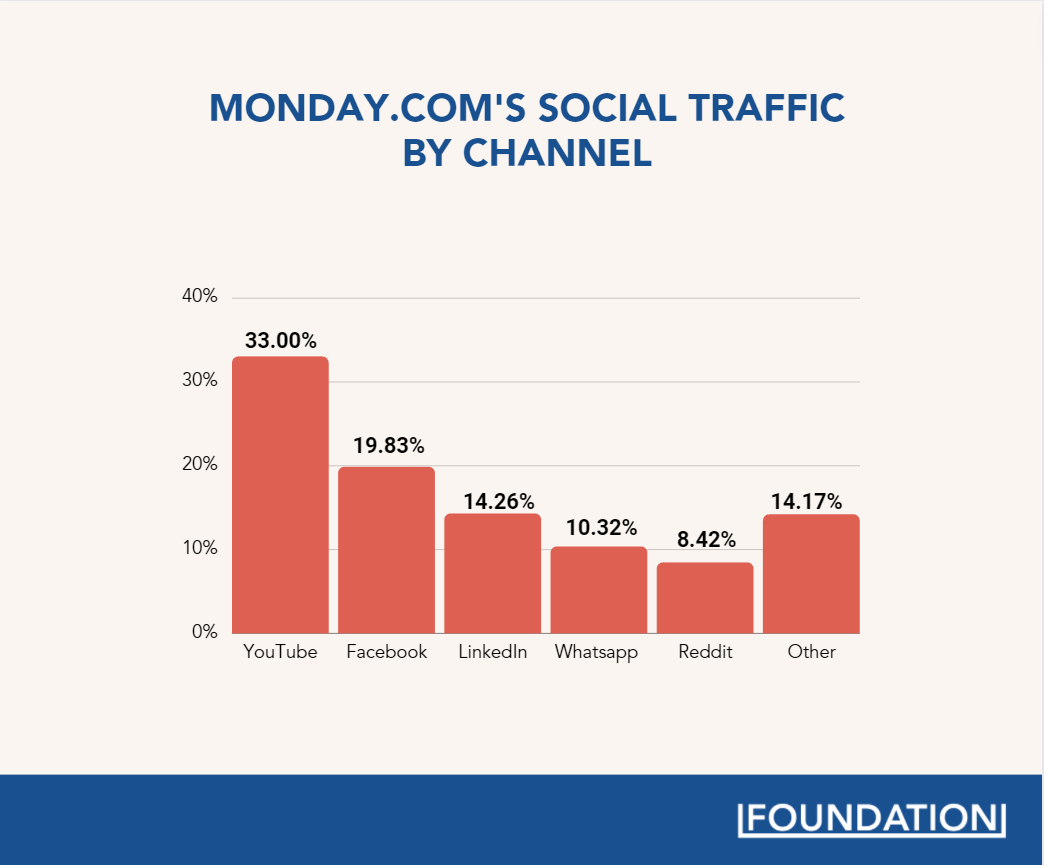
How Monday Uses YouTube to Drive Growth
The monday.com YouTube channel is a perfect example of how a diversified content portfolio drives brand growth. With nearly 100 million total views, the monday.com team has built another hub for content that educates, engages, and entertains.
Out of the top competitors in the project management platform space, monday.com is leading the way. The numbers don’t lie:
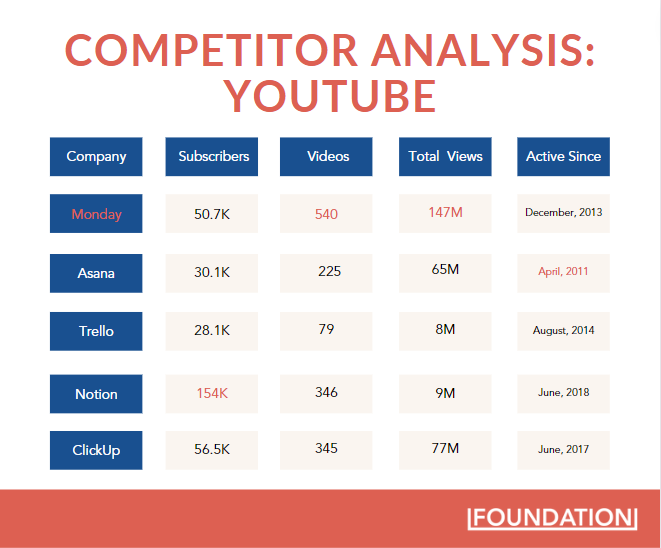
Monday.com is not only putting out the most video content in its niche, but they’re also winning the most eyeballs. And not by a small margin. They get as many views as the rest of their competitor’s channels combined.
That’s a lot of inches right there.
And when you take a dive into the content itself, the massive success of this channel becomes clearer. All of the top-viewed content on their YouTube channel clocks in around or under the 1-minute mark.
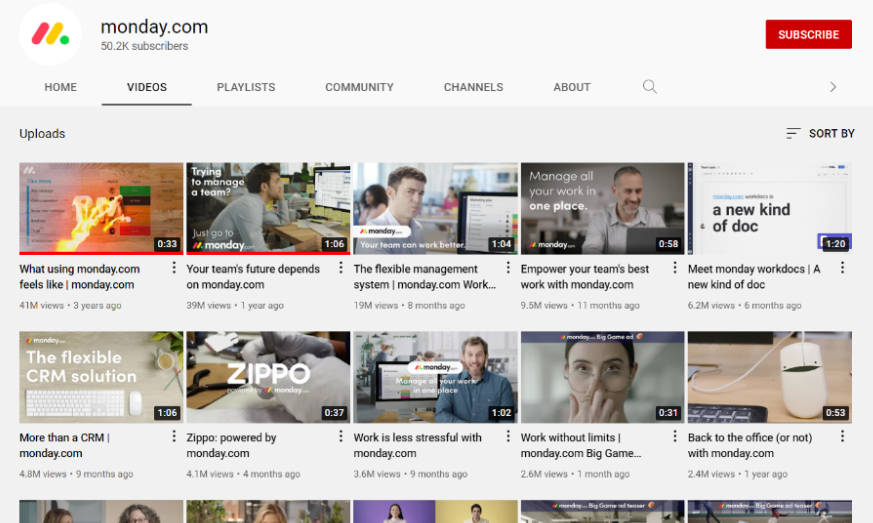
That’s not exactly a common occurrence for a Saas company.
Lots of companies in the space leverage their API documentation and training processes to populate YouTube. It matches with search intent, keeps current users happy, and allows potential buyers to witness workflows firsthand. You know, the educational stuff.
Monday.com even has different playlists to make the user experience as smooth as possible.
Check this out:

Instead of slogging through the full archive to find a projects overview video or tutorial on the monday.com app’s formula function, they separate education videos into the following categories:
- Getting started
- Marketing
- Project management
- Monday.com sales CRM
- Tutorials
But they don’t stop there. Each of these categories is colour-coded, so frequent visitors can quickly identify what new videos are about. This is the type of effort that often goes unnoticed but is critical to gaining those extra inches.
But the real yardage comes from another class of videos altogether.
Despite offering numerous YouTube playlists that cater to product learners, it turns out monday.com’s success on the platform has a lot to do with the other two E’s: entertainment and engagement.
Let’s take a look at the second most viewed video on their channel — an ad titled “your team’s future depends on monday.com.” Clocking in at 39 million views, the video blends perfect ad copy with quality video production and an ingenious premise.
Take a second to watch it for yourself:
Now check out the comments while you’re at it. Notice a theme?
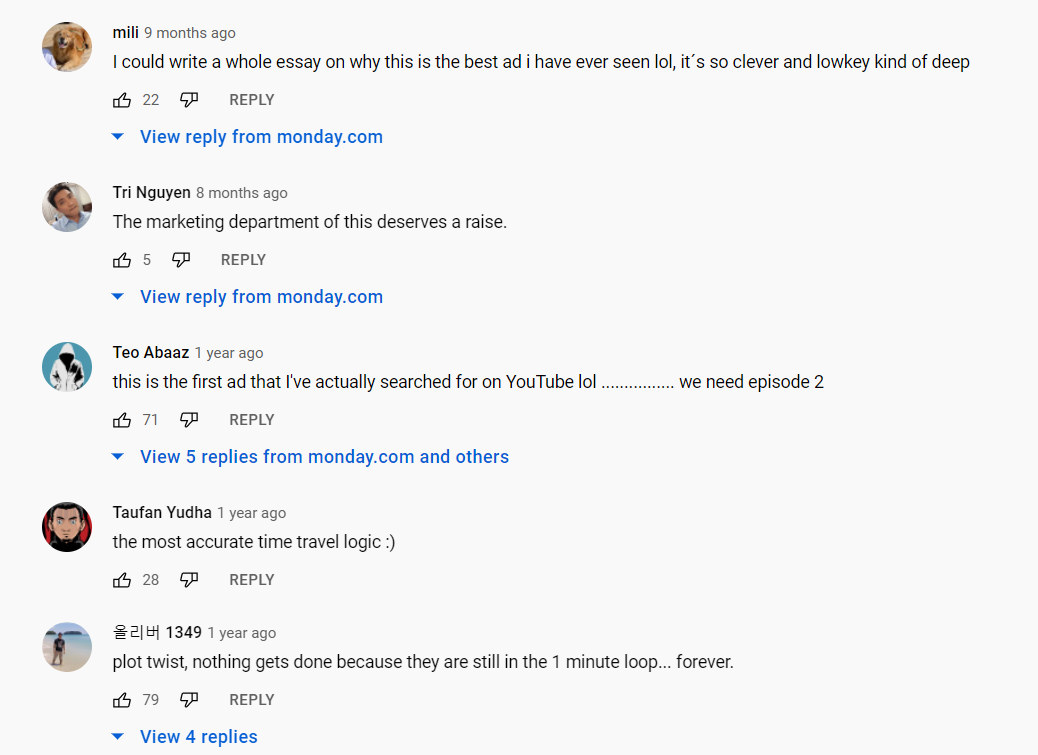
They read like an IMDB page for a Christopher Nolan movie.
This isn’t exactly the discourse you expect to find on a project management software company’s YouTube channel. But a large part of the company’s brand is selling its customers on the reality of “working without limits.”
Monday.com is really taking the “create content that shapes culture” concept to another level and the public is eating it up.
The success of their YouTube channel and advertising campaigns on the platform even laid the groundwork for a successful transition into offline marketing efforts.
The Role That Traditional Advertising Plays
The constant growth of internet advertising is putting serious pressure on traditional advertising. Where billboards, bus stops, and transit placements used to come at a premium, digital analogs have taken their place. Brands are more concerned with breaking ground online, and monday.com is capitalizing on the open space for physical ads.

They’re snatching up every inch of the marketing field.
And it’s clearly a championship formula.
Just over a month ago, during one of the most iconic Super Bowl halftime shows in recent memory, over 100,000,000 people saw monday.com’s TV ad. In its tenth year as a company, this plucky startup from Israel just reached the pinnacle of marketing success.
Like Coach said, B2B SaaS success is a game of inches.
You know this.
Now, as the offensive coordinator of the marketing team, it’s time you start putting some of the techniques outlined today into action. Revamping your strategy with these plays will help create inches of separation from your competitors every single day. te
Do this by investing in SEO. Do this by investing in long-form content and distribution. Do this by investing in YouTube. Do this by investing in traditional advertising…
Do it in whatever combination works best for your brand.
Because, at the end of the day, what matters isn’t how you do it.
What matters is that you don’t just walk away from reading this blog post feeling like you learned something. You need to walk away from reading this blog ready to act on something.
So take a second… scroll back up.
Find an insight you can build from and start creating that separation… inch by inch.







